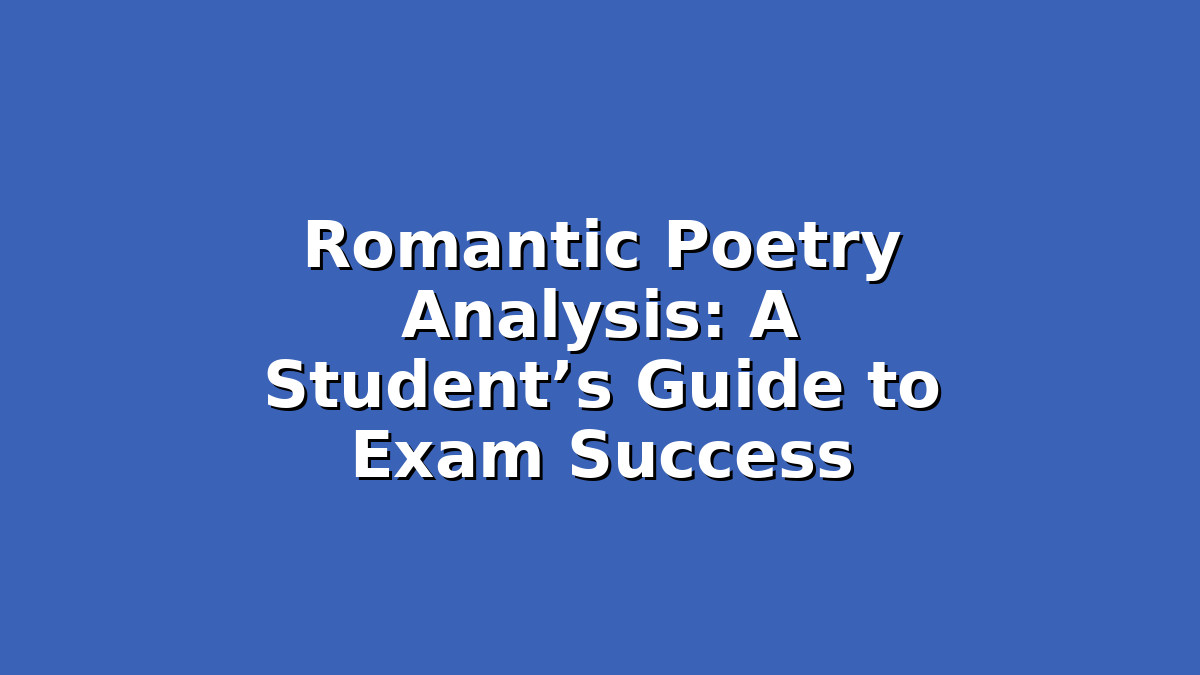Romantic poetry holds a special place in literature, celebrated for its deep emotions, vivid imagery, and focus on nature, individuality, and imagination. For students preparing for exams, understanding how to analyze Romantic poetry can seem daunting at first. However, with the right approach and study techniques, you can unlock the beauty and meaning behind these poems and impress your examiners with confident, insightful responses.
In this guide, we’ll explore practical tips and strategies to help you analyze Romantic poetry effectively. Whether you’re tackling works by William Wordsworth, Samuel Taylor Coleridge, John Keats, or Lord Byron, these study methods will boost your understanding and exam performance.
1. Understand the Key Themes and Characteristics of Romantic Poetry
Before diving into detailed analysis, it’s important to familiarize yourself with the core features of Romantic poetry. Romantic poets reacted against the industrial revolution and the Enlightenment’s focus on reason, instead emphasizing emotion, nature, and the individual’s imagination. Knowing these themes will help you identify the poem’s underlying messages.
Key Themes to Look For:
– Nature: Often portrayed as a source of beauty, inspiration, and spiritual renewal.
– Emotion and Individual Experience: Romantic poetry values intense feelings and personal reflection.
– Imagination and Creativity: Poets celebrate the power of imagination to transcend reality.
– The Past and the Supernatural: Many poems explore history, mythology, or supernatural elements.
– The Sublime: A sense of awe and wonder, often in response to nature’s grandeur or human emotions.
Study Tips:
– Create a mind map of Romantic themes and examples from your poetry texts.
– When reading a poem, highlight phrases or images that relate to these themes.
– Use flashcards with key terms (e.g., “the sublime,” “nature”) and their definitions to reinforce your understanding.
By mastering these themes, you’ll be able to quickly spot what the poem is about, which is crucial when under exam pressure.
2. Break Down the Poem’s Structure and Language Techniques
Romantic poetry is rich in literary devices that convey emotion and meaning. Analyzing these techniques allows you to explore how the poet brings their ideas to life. Focus on the following areas when studying a poem:
Form and Structure:
– Look at the poem’s stanza arrangement and rhyme scheme. Does it have a regular pattern, or is it free verse?
– Notice the rhythm and meter. Is it steady or varied to create a particular mood?
– Consider the poem’s progression. Does it tell a story, describe a scene, or explore a feeling?
Language and Imagery:
– Identify key metaphors and similes. How do they deepen the meaning?
– Examine sensory language. Romantic poets often use vivid descriptions involving sight, sound, touch, taste, and smell.
– Find examples of personification, where nature or abstract ideas are given human qualities.
– Look for symbolism—objects or images that represent bigger ideas.
Sound Devices:
– Pay attention to alliteration, assonance, and consonance, which create musicality.
– Note any repetition or refrains that emphasize important themes.
Study Tips:
– Annotate poems by underlining or highlighting different literary devices in different colors.
– Practice writing mini-analyses focusing on one device at a time.
– Use diagrams to map out rhyme schemes or stanza patterns.
Breaking the poem down in this way will help you write organized and detailed answers, demonstrating a strong grasp of both content and technique.
3. Develop Critical Thinking and Personal Response Skills
Exams often require more than just identifying themes and techniques; they want you to engage critically with the poem and offer your own interpretations. Romantic poetry is ideal for this because of its emotional depth and open-ended meanings.
Ask Yourself These Questions:
– What emotions does the poem evoke, and how do they relate to the poet’s message?
– How does the poet’s use of nature reflect their view of the world?
– In what ways does the poem challenge or reinforce Romantic ideals?
– How might historical or biographical context influence the meaning?
Tips for Forming Personal Responses:
– Use evidence from the poem to support your ideas. Quote specific lines and explain their significance.
– Avoid overly general statements. Be precise in your analysis.
– Link your ideas back to the question or prompt to stay focused.
– Practice writing introductions and conclusions that summarize your interpretation clearly.
Study Tips:
– Discuss poems with classmates or teachers to hear different perspectives.
– Write practice essays under timed conditions to build confidence.
– Record yourself explaining a poem aloud to clarify your thoughts.
By developing your critical voice, you’ll create more engaging and thoughtful exam responses that stand out.
Conclusion
Analyzing Romantic poetry doesn’t have to be intimidating. By understanding the movement’s key themes, breaking down structure and language, and cultivating your own interpretive skills, you’ll be well-prepared to tackle any poem your exam throws at you. Remember, Romantic poetry invites you to connect with emotions and nature, so allow yourself to enjoy the process of discovery as you study. With consistent practice and a positive mindset, you can approach your exams confidently and achieve great results.
Keep revisiting your notes, practicing analysis, and discussing poems to deepen your understanding. You’ve got this!

Responses